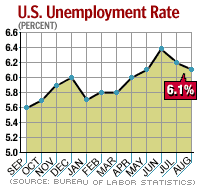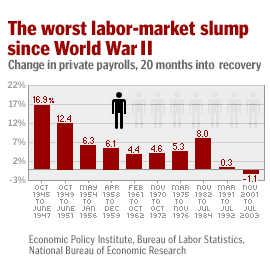NEW YORK (CNN/Money) -
Employers slashed nearly 100,000 jobs in August, the government said Friday, defying private economists' forecasts for an increase and highlighting fears that the labor market could be slow to catch up to stronger growth in the rest of the economy.
Payrolls shrank by 93,000 jobs outside the farm sector, the Labor Department said, after falling a revised 49,000 jobs in July. Economists had expected payrolls to grow, according to a Reuters poll. The number of jobs lost was the biggest since 151,000 in March.

"The report was surprisingly weak and highlights the reality that, until forced to do so by ever-increasing demand, firms will not commit to new workers," said Joel Naroff, president and chief economist of Naroff Economic Advisors in Holland, Pa.
The unemployment rate edged down to 6.1 percent from 6.2 percent in July, the government said. The two numbers sometimes move in opposite directions because they are generated by separate surveys.
But the unemployment rate fell last month mostly because the size of the labor force -- the number of working-age people working or looking for work -- shrank by 10,000, following a loss of 556,000 in July.
About 8.9 million people were counted as unemployed in August, compared with 9 million in July. About 1.9 million have been out of work 27 weeks or more.
In its report, the department said the blackout in the Northeast United States, which occurred during the department's survey week, probably had little impact on the data.
On Wall Street, stocks sank after the report while Treasury bond prices rose.
Political heat grows
The report is likely to add to the political heat on President Bush, who is faced with the dismal prospect of running for re-election in 2004 as the first president since Herbert Hoover to have a net number of jobs lost during his four-year term.
"At this rate, there will be only one job left to cut by November 2004: George Bush's," said Sen. Joseph Lieberman (D-Conn.), one of nine Democratic candidates vying for their party's nomination to challenge Bush in 2004.
Bush pushed for -- and won -- tax cuts earlier this year that his Council of Economic Advisers predicted would create 5.5 million jobs between July 2003 and the end of 2004, with most of that job creation coming at the front end. So far, the administration's predictions have missed the mark.
"We've cut a $3 trillion hole in the budget for the next three years for tax cuts he said were going to create 344,000 jobs each month starting in August, and things are going in the opposite direction," said Lawrence Mishel, president of the Economic Policy Institute, a liberal think tank in Washington that launched a Web site Friday to tally job growth.
Still, the administration expressed optimism. Secretary of Labor Elaine Chao told CNNfn she was pleased the unemployment rate fell and pointed to job growth in some industries. And White House economic adviser Gregory Mankiw told Reuters the job market was due for a turnaround, but it would take time.
"The economy is like a supertanker," Mankiw said. "It doesn't move on a dime. Policy can nudge it, but it takes a while before it starts moving and moving substantially."
Longest slump since WWII
Non-farm payrolls are now 2.8 million jobs lower than they were in March 2001, when the National Bureau of Economic Research said a recession began. Though that recession ended in November 2001, the labor market has still not recovered, making this the longest "jobless recovery" since World War II.

Economists have seen renewed strength in manufacturing and retail sales and predicted gross domestic product could accelerate to grow at a 5 percent rate in the third quarter, from a 3.1 percent rate in the second quarter and a 1.4 percent in the first.
But many economists have also warned the labor market could be slow to enjoy the rebound, with productivity growth racing at breakneck speed. Productivity, a measure of output per worker hour, grew at a 6.8 percent annual pace in the second quarter, up from a 5.4 percent rate in 2002, which was the fastest pace since 1950.
The fear is that a weak labor market could weigh on consumer confidence and, perhaps more important, wage growth. Consumer spending fuels two-thirds of GDP; if spending is flat, the economy could become sluggish again.
"If even 5 to 6 percent GDP growth isn't enough to get any net hiring, then the risks rise that the stimulus from the tax cuts and defense spending could produce a one-time boost that will fizzle out next year," said Bill Cheney, chief economist at John Hancock Financial Services in Boston.
Surprising drop in service jobs
In Friday's report, average hourly wages rose 2 cents to $15.45 an hour from $15.43 in July.
| Related stories
|

|
|
|
|
Much of the drop in the payrolls report came from a loss of 67,000 jobs in the service sector, which employs 88 percent of all the workers in the United States. It was the biggest drop since 119,000 in March.
Payrolls in goods-producing industries fell 26,000 in August, including 44,000 jobs cut from the manufacturing sector, which has shed jobs for 37 straight months. Many of those jobs are unlikely to return, many economists believe.
In one hopeful sign, payrolls of temporary workers grew by 7,000 in August, the fourth straight month of gains. Employers will often use temps before they start hiring permanent workers. But the prior months' gains in temp workers were revised downward and have been growing smaller and smaller each month.
The average workweek was flat at 33.6 hours, indicating businesses held activity steady in August.

|

